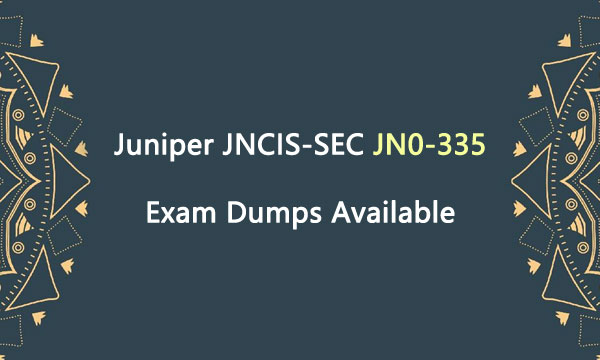Juniper JNCIS-SEC JN0-335 Exam Dumps Available
February 06,2023 01:32 AM
Juniper JN0-335 exam is a required test for Juniper JNCIS-SEC certification, which is designed for networking professionals with intermediate knowledge of the Juniper Networks Junos OS for SRX Series devices. The written Juniper JN0-335 exam verifies your understanding of security technologies and related platform configuration and troubleshooting skills. We have cracked the latest Juniper JNCIS-SEC JN0-335 exam dumps, which are valid in the preparation.

Juniper Certification JN0-335 Exam
Juniper certification JN0-335 exam basic information is available below for you to study.
Number of questions: 65 multiple-choice questions
Duration: 90 minutes
Language: English
Note: Pass/fail status is available immediately after taking the Juniper JN0-335 exam.
JN0-335 Juniper JNCIS-SEC Exam Objectives
Juniper JNCIS-SEC JN0-335 exam objectives cover the following Security, Specialist (JNCIS-SEC) exam objectives.
Application Security
Security Policies (Advanced)
Advanced Threat Prevension (ATP)
High Availability (HA) Clustering
Juniper Networks vSRX Virtual Firewall or cSRX Container Firewall
Juniper Identity Management Service (JIMS)
SSL Proxy
Juniper Networks JSA Series Secure Analytics Portfolio
Practice Juniper JN0-335 Exam Dumps
The latest Juniper certification JN0-335 exam dumps are the best material for you to test the above Security, Specialist (JNCIS-SEC) exam objectives. Share some Juniper JN0-335 exam dumps questions and answers below.
1.A routing change occurs on an SRX Series device that involves choosing a new egress interface. In this scenario, which statement is true for all affected current sessions?
A. The current session are torn dowm only if the policy-rematch option has been enabled.
B. The current sessions do not change.
C. The current sessions are torn down and go through first path processing based on the new route.
D. The current sessions might change based on the corresponding security policy.
Answer: B
2.Which three statements are correct about fabric interfaces on the SRX5800? (Choose three.)
A. Fabric interfaces must be user-assigned interfaces.
B. Fabric interfaces must have a user-assigned IP address.
C. Fabric interfaces must be same interface type.
D. Fabric interfaces must be on the same Layer 2 segment.
E. Fabric interfaces must be system-assigned interfaces.
Answer: C,D,E
3.What are two types of attack objects used by IPS on SRX Series devices? (Choose two.)
A. protocol anomaly-based attacks
B. spam-based attacks
C. signature-based attacks
D. DDoS-based attacks
Answer: A,C
4.You are asked to enable AppTrack to monitor application traffic from hosts in the User zone destined to hosts in the Internet zone.
In this scenario, which statement is true?
A. You must enable the AppTrack feature within the Internet zone configuration.
B. You must enable the AppTrack feature within the ingress interface configuration associated with the Internet zone.
C. You must enable the AppTrack feature within the interface configuration associated with the User zone.
D. You must enable the AppTrack feature within the User zone configuration.
Answer: D
5.You must configure JSA to accept events from an unsupported third-party log source. In this scenario, what should you do?
A. Separate event collection and flow collection on separate collectors.
B. Configure an RPM for a third-party device service module.
C. Configure JSA to silently discard unsupported log types.
D. Configure a universal device service module.
Answer: D
JN0-335 Exam Dumps PDF & SOFT | 1 Year Free Update | Money Back Guarantee
- Related Suggestion
- Juniper Certification Exams Information You Want to Know April 17,2023
- Pass Juniper JN0-637 Exam to Earn JNCIP-SEC Certification July 08,2024
- 2024 New Updated Juniper JNCIA-Junos JN0-105 Exam Dumps Available March 01,2024
- The Role of JNCIA-Junos Certification in Career Advancement August 16,2023
- JN0-636 JNCIP-SEC Security,Professional Dumps December 17,2022

